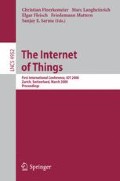Abstract
This paper analyses why marketing short range devices (SRD) as radio frequency identifiers (RFID) might backfire on the RFID industry. To support this claim it provides a legal use case as basis and gives an overview of selected technical parameters of RFID. Furthermore an analysis of 43 legal articles shows that legal experts perceive the technology of RFID in an undifferentiated way. Finally an analysis of 11 tag providers of so called “active RFID tags” shows that SRD are marketed as active RFID. It concludes that in order to avoid inhibiting legal consequences which might have negative effect on the RFID industry a differentiated approach regarding the functionality of short range transmitters and RFID is necessary.
Access this chapter
Tax calculation will be finalised at checkout
Purchases are for personal use only
Preview
Unable to display preview. Download preview PDF.
References
Asamoah, A.K.: Not as easy as it appear: Using radio frequency identification technology to fulfill the prescription drug marketing act’s elusive pedigree requirement. Food and Drug Law Journal 61, 385 (2006)
Bensky, A. (ed.): Short-range wireless communication, 2nd edn(ed.). Elsevier, Amsterdam (2004)
Brito, J.: Relax don’t do it: Why RFID privacy concerns are exaggerated and legislation is premature. UCLA Journal of Law and Technology 5 (2004)
Cardwell v. Lewis, 417 U.S. 583 (1974)
Dalal, R.S.: Chipping away at the constitution: The increasing use of RFID chips could lead to an erosion of privacy rights. Boston University Law Review 86, 485 (2006)
Delaney, K.: RFID: Privacy year in review: America’s privacy laws fall short with RFID regulation. A Journal of Law and Policy for the Information Society 1, 543 (2005)
Eden, J.M.: When big brother privatizes: Commercial surveillance, the privacy act of 1974, and the future of RFID. Duke Law & Technology Review 20 (2005)
Eleftheriou, D., Berliri, M., Coraggio, G.: Data protection and E-commerce in the United States and the European Union. International Lawyer 40, 393 (2006)
Eng, G.: Technology trends affecting the practice of law. Los Angeles Lawyer 79, 28-APR (2005)
Eschet, G.: FIPS and PETS for RFID: Protecting privacy in the web of radio. Jurimetrics Journal 45, 301 (2005)
Finkenzeller, K.: RFID Handbuch (4. Auflage). Hanser, München (2006)
Glover, B., Bhatt, H.: RFID essentials, 1st edn (ed.) O’Reilly, Beijing (2006)
Handler, D.: The wild, wild west: A privacy showdown on the radio frequency identification (RFID) systems technological frontier. Western State University Law Review 32, 199 (2005)
Herbert, W.A.: No direction home: Will the law keep pace with human tracking technology to protect individual privacy and stop geoslavery? A Journal of Law and Policy for the Information Society 2, 409 (2006)
Katz v. United States, 389 U.S. 347 (1967)
Kern, C.: Anwendung von RFID-systemen. Springer, Berlin (2006)
Kobelev, O.: Big brother on a tiny chip: Ushering in the age of global surveillance through the use of radio frequency identification technology and the need for legislative response. North Carolina Journal of Law & Technology 6, 325 (2005)
Koops, B., Leenes, R.: ’Code’ and the slow erosion of privacy. Michigan Telecommunications and Technology Law Review 12, 115 (2005)
Kyllo v. Unites States, 533 U.S. 29 (2001)
Landau, S.: Digital age communications law reform: National security on the line. Journal on Telecommunications & High Technology Law 4, 409 (2006)
U.S. National Prohibition Act, ch. 85, 41 Stat. 305 (1919)
Olmstead v. United States, 277 U.S. 438 (1928)
Smith, S.L.: Symposium review: RFID and other embedded technologies: Who owns the data? Santa Clara Computer and High Technology Law Journal 22, 695 (2006)
Smith, S.L.: Gone in a blink: The overlooked privacy problems caused by contactless payment systems. Marquette Intellectual Property Law Review 11, 213 (2007)
Stark, S.C., Nagle, E.P.: Full speed ahead with DOD identification requirements: Next stop, radio frequency identification. Procurement Lawyer 40-Fall, 11 (2004)
Stein, S.G.: Where will consumers find privacy protection from RFID?: A case for federal legislation. Duke Law & Technology Review 2007, 3 (2007)
Terry, N.P.: Assessing the technical, conceptual, and legal frameworks for patient safety information. Widener Law Review 12, 133 (2005)
Thompson, D., Kot, K., Brothers, J.: Radio frequency identification: Legal aspects. Richmond Journal of Law and Technology 12, 6 (2005)
U.S. Const. Amend. IV
United States v. Knotts, 460 U.S. 276 (1983)
Willingham, K.M.: Scanning legislative efforts: Current RFID legislation suffers from misguided fears. North Carolina Banking Institute 11, 313 (2007)
AAiD: (last visited December 9, 2007), http://www.autoaccessid.com/Files/File/Cutsheets/AA-T800.pdf
AeroScout: (last visited December 9, 2007), http://www.aeroscout.com/data/uploads/AeroScout%20T3%20Tag%20Data%20Sheet.pdf
Axcess: (last visited December 9, 2007), http://www.axcessinc.com/products/docs/containertag.pdf
Multispectral: (last visited December 9, 2007), http://www.multispectral.com/pdf/Sapphire_VISION.pdf
R.F Code: (last visited December 9, 2007), http://www.rfcode.com/images/media_kit_docs/m100_tech_spec_sheet.pdf
RFID Inc.: (last visited December 9, 2007), http://www.rfidinc.com/products1.html
RFind: (last visited December 9, 2007), http://www.rfind.com/pdf/RFind%20Tags%20Gateway%20_V1.5_%2005-01-07.pdf
Savi: (last visited December 9, 2007), http://www.savi.com/products/SaviTag_656.pdf
Synometrix: (last visited December 9, 2007), http://www.synometrix.com/SYNOMETRIX_SMPTK-002_active_RFID_tag_specification.pdf
Ubisense: (last visited December 9, 2007), http://www.ubisense.net/media/pdf/Ubisense%20Compact%20Tag%20EN%20V1.0.pdf
Wherenet: (last visited December 9, 2007), http://www.wherenet.com/pdf/products/WhereTagIII.6.14.07.pdf
EPC global Inc., Glossary: (last visited December 9, 2007), http://www.epcglobalinc.org/what/cookbook/chapter5/039–GlossaryV.6.0May2005FINAL.pdf
RFID Journal: (last visited December 9, 2007), http://www.rfidjournal.com/article/glossary/3
Author information
Authors and Affiliations
Editor information
Rights and permissions
Copyright information
© 2008 Springer-Verlag Berlin Heidelberg
About this paper
Cite this paper
Ronzani, D. (2008). Why Marketing Short Range Devices as Active Radio Frequency Identifiers Might Backfire. In: Floerkemeier, C., Langheinrich, M., Fleisch, E., Mattern, F., Sarma, S.E. (eds) The Internet of Things. Lecture Notes in Computer Science, vol 4952. Springer, Berlin, Heidelberg. https://doi.org/10.1007/978-3-540-78731-0_14
Download citation
DOI: https://doi.org/10.1007/978-3-540-78731-0_14
Publisher Name: Springer, Berlin, Heidelberg
Print ISBN: 978-3-540-78730-3
Online ISBN: 978-3-540-78731-0
eBook Packages: Computer ScienceComputer Science (R0)

